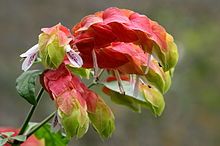If you’re looking to add a splash of color and vibrancy to your garden, the shrimp plant is an excellent choice.
With its unique, tubular flowers that resemble shrimp, this tropical beauty not only catches the eye but also brings warmth and life to any space.
However, like all plants, shrimp plants need a little TLC to thrive. One essential aspect of their care is fertilization. But when exactly should you roll up your sleeves and start feeding these lovely plants?
Timing can make all the difference in ensuring they flourish beautifully throughout the seasons. Let’s dive into everything you need to know about optimizing your fertilization schedule for healthy and thriving shrimp plants!
Understanding the Shrimp Plant: A Brief Overview
The shrimp plant, scientifically known as Justicia brandegeeana, is a captivating perennial native to Central and South America. Its striking flowers are bright orange or yellow and grow in clusters that look remarkably like shrimp—hence the name.
This tropical gem can grow up to three feet tall and thrives in warm climates. It prefers well-draining soil with plenty of organic matter.
Shrimp plants love partial shade but can also tolerate full sun if given enough water. Their lush green foliage adds texture to any garden setting while attracting hummingbirds and butterflies.
These plants bloom from spring through fall, creating a stunning display throughout the growing season. Proper care, including attention to watering and fertilizing schedules, can enhance their growth significantly, making them an excellent choice for gardeners looking for vibrant color year-round.
The Importance of Fertilizing Shrimp Plants
Fertilizing shrimp plants is crucial for their growth and vibrancy. These tropical beauties thrive in rich, nutrient-filled soil. Without proper fertilization, they may struggle to reach their full potential.
Nutrients like nitrogen, phosphorus, and potassium play key roles. Nitrogen fosters lush foliage, while phosphorus encourages flowering. Potassium strengthens plants against diseases and promotes overall health.
A well-fertilized shrimp plant showcases brighter colors and more blooms throughout the growing season. It not only enhances beauty but also supports resilience against pests.
Timing matters too; feeding during active growth ensures your plant gets what it needs when it needs it most. This practice helps maintain a robust root system essential for stability and water uptake.
Incorporating organic fertilizers can further enrich the soil without chemical buildup. The right balance of nutrients leads to thriving shrimp plants that captivate any garden or patio space.
Factors to Consider When Deciding on Fertilization Timing
Timing is crucial when it comes to fertilizing shrimp plants. Various factors can influence the ideal moment for this important task.
First, consider the plant’s growth cycle. Fertilization during active growing periods yields better results than applying nutrients during dormancy.
Weather conditions play a role too. Warmer temperatures often stimulate growth, making spring an excellent time for fertilizer application.
Additionally, soil health cannot be ignored. Testing your soil can reveal nutrient deficiencies that dictate when and how much fertilizer to use.
Observe your shrimp plants closely as well. Signs of yellowing leaves or stunted growth indicate that they may need a nutrient boost sooner rather than later.
Remember to check local climate patterns. Different regions experience varied seasons which affect optimal fertilization timing significantly.
Early Spring: The Ideal Time for Fertilizing Shrimp Plants
Early spring marks a crucial period for shrimp plants. As temperatures begin to rise, these vibrant beauties awaken from their winter slumber. It’s the perfect time to give them a nutrient boost.
During this season, growth hormones kick into gear. Fertilizing at this stage supports healthy leaf and flower development. The plants utilize nutrients more effectively when they are actively growing.
Choose a balanced fertilizer that promotes both root and foliage health. Applying it in early spring sets the foundation for lush growth throughout the warmer months.
Remember to water your shrimp plants before fertilization. This ensures better nutrient absorption and reduces the risk of root burn. With proper care during early spring, your shrimp plants can truly thrive as they head into their peak growing season.
Other Considerations for Fertilizing Shrimp Plants
When fertilizing shrimp plants, it’s essential to consider their growing environment. Factors like light exposure and temperature can significantly impact nutrient uptake. Ensure your plants are in an area where they receive bright, indirect sunlight for optimal growth.
Watering practices also play a crucial role. Overwatering can leach nutrients away from the soil, while underwatering may stress the plant, hindering its ability to absorb fertilizers effectively. Maintain a balanced watering schedule.
Additionally, monitor your shrimp plant for signs of nutrient deficiency or excess. Yellow leaves might indicate nitrogen shortage, while burnt leaf tips could suggest over-fertilization. Adjust accordingly based on these visual cues.
Consider seasonal changes too. Shrimp plants experience varying growth rates throughout the year; adjusting fertilization frequency during dormant months is wise for healthy development and sustainability.
Common Mistakes to Avoid When Fertilizing Shrimp Plants
Fertilizing shrimp plants can be tricky if you’re unaware of common pitfalls. One frequent mistake is over-fertilizing. Too much fertilizer can burn the roots and hinder growth.
Another issue arises from using the wrong type of fertilizer. Shrimp plants thrive on balanced, slow-release fertilizers tailored for tropical plants. Using a high-nitrogen formula may lead to lush foliage but fewer flowers.
Timing is also crucial. Fertilizing during dormancy in winter won’t yield results, as the plant isn’t actively growing. Stick to fertilizing in early spring when growth kicks off.
Inconsistent application poses its own challenges too. Regularly feeding your shrimp plant ensures it gets the nutrients needed to flourish throughout the growing season.
Neglecting soil quality can impact nutrient uptake significantly. Ensure good drainage and organic matter presence for optimum health before adding any fertilizers into the mix.
Conclusion
A well-cared-for shrimp plant can bring vibrant colors to your garden or home. With proper fertilization, these beautiful plants will thrive and reward you with stunning blooms.
Remember that timing plays a crucial role in the success of your shrimp plant care routine. Early spring is often the best window for fertilizing, as it aligns with their natural growth cycle.
Moreover, understanding the specific needs of your shrimp plants ensures you choose the right fertilizer. Each variety may have unique requirements based on its environment and health.
Stay observant while tending to your plants. Watch for signs indicating they need nutrients or adjustments in care practices. This attentiveness fosters a healthier growing experience.
With dedication and knowledge about effective fertilization strategies, cultivating thriving shrimp plants becomes an achievable goal.
Introduction to Shrimp Plants
Shrimp plants, scientifically known as Justicia brandegeeana, are fascinating tropical perennials. They thrive in warm environments and can bring a splash of color to any garden or indoor space.
These plants get their name from their unique flower shape, resembling shrimp. The vibrant orange and yellow blooms attract pollinators like hummingbirds and butterflies, adding life to your outdoor area.
With lush green leaves and an upright habit, shrimp plants make excellent choices for borders or containers. They flourish when given the right care.
Understanding how these beautiful specimens grow is essential for anyone interested in gardening. Knowing their needs will help you create a thriving environment that showcases their beauty year-round.
Understanding the Fertilization Process
Fertilization is essential for the health of shrimp plants. It involves providing nutrients that support growth and flowering.
Shrimp plants thrive on a balanced mix of macronutrients like nitrogen, phosphorus, and potassium. These elements are crucial for developing foliage, strong stems, and vibrant blooms.
Micronutrients also play a vital role in their overall vitality. Elements such as iron and magnesium ensure chlorophyll production and photosynthesis efficiency.
Timing your fertilization can significantly impact how well your shrimp plant performs throughout the growing season. An optimal approach considers seasonal changes to align nutrient supply with plant needs.
The right fertilizer type matters too—slow-release granules or liquid fertilizers can yield different results based on application techniques. Understanding these factors allows you to create an effective care routine tailored specifically for your shrimp plant’s requirements.
Factors Affecting the Best Time to Fertilize Shrimp Plants
Several factors influence the best time to fertilize shrimp plants. Understanding these can lead to healthier, vibrant growth.
Temperature plays a crucial role. Shrimp plants thrive in warmer weather, so timing your fertilization during mild spring temperatures boosts nutrient absorption.
Light exposure is another key element. Adequate sunlight promotes photosynthesis, helping the plant utilize nutrients effectively. If your shrimp plants are indoors or shaded, consider adjusting your fertilization schedule accordingly.
Moisture levels in the soil matter too. Fertilizing when the soil is dry can stress roots and hinder nutrient uptake. Monitor soil moisture before applying fertilizer for best results.
Growth stage impacts timing as well. Young seedlings have different needs compared to mature plants; adjust your approach based on their development phase for optimal health and blooming potential.
The Importance of Choosing the Right Fertilizer
Choosing the right fertilizer for shrimp plants is crucial for their health and vibrancy. Each type of fertilizer has unique nutrients that cater to specific growth needs.
For instance, a balanced formula provides essential macronutrients like nitrogen, phosphorus, and potassium. These elements support overall plant vitality and flowering.
Organic options offer slow-release benefits while enriching the soil with beneficial microorganisms. This promotes healthier root systems over time.
Conversely, synthetic fertilizers can deliver quick results but may lead to nutrient imbalances if not monitored closely.
Understanding your shrimp plant’s specific requirements will guide you toward making an informed choice. Observing how they respond post-fertilization also helps in fine-tuning your approach for optimal growth.
Best Times to Fertilize Shrimp Plants Based on Season
When it comes to fertilizing shrimp-plants, timing is everything. In spring, as temperatures rise and daylight increases, these vibrant shrubs enter a growth spurt. This season marks the perfect opportunity to apply fertilizer. A balanced formula can invigorate your plant’s lush foliage.
As summer progresses, continue monitoring your shrimp plant’s health. If you notice signs of slowed growth or yellowing leaves, it might be time for another feeding.
In the fall, consider reducing fertilizer application as the plant prepares for dormancy. During this period, a light touch with nutrients can assist in maintaining vigor without overstimulating new growth.
Winter is typically a resting phase for shrimp-plants; therefore, skip fertilization altogether during these colder months to prevent stress on the roots and allow them to conserve energy until spring returns.
Tips for Properly Fertilizing Shrimp Plants
When fertilizing shrimp plants, timing and technique matter. Start with a balanced fertilizer that contains equal parts nitrogen, phosphorus, and potassium. This promotes healthy growth without overwhelming the plant.
Apply fertilizer during the growing season, typically in early spring. Dilute it to half-strength to avoid burning the roots. Remember, less is often more when it comes to nutrients.
Water your shrimp plants before applying fertilizer. Moist soil helps facilitate nutrient absorption and reduces stress on the plant.
Consider using slow-release fertilizers for consistent nourishment throughout several months. Granules can work wonders by providing a steady supply of nutrients as they break down over time.
Regularly monitor your plants for signs of deficiency or excess—such as yellowing leaves or stunted growth—and adjust your feeding schedule accordingly. Each shrimp plant has unique needs based on its environment and care routine.
Conclusion: Keeping Your Shrimp Plants Healthy and Thriving
To keep your shrimp plants healthy and thriving, understanding their unique needs is essential. Fertilizing at the right time can significantly enhance growth and blooming potential. Early spring is typically ideal, as it aligns with the plant’s natural growth cycle.
Be mindful of environmental factors such as temperature and humidity when planning to fertilize. Additionally, selecting a fertilizer tailored for flowering plants can make all the difference in promoting vibrant blooms.
Avoid common pitfalls like over-fertilization or applying nutrients during dormancy periods. Instead, focus on providing consistent care throughout growing seasons.
By paying attention to these details, you set your shrimp plants up for success and ensure they remain a stunning addition to your garden or home environment. Happy gardening!





